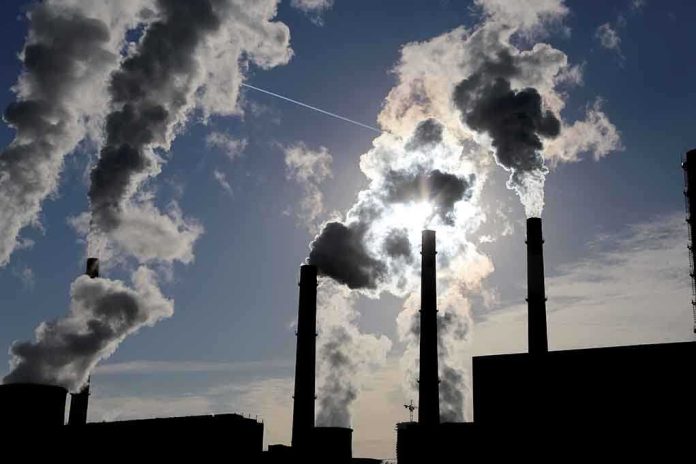
One split-second leak of industrial ammonia sent a quiet Oklahoma town into chaos—and the aftershocks will shape how America thinks about chemical safety for years to come.
Story Snapshot
- Dozens hospitalized and 11 critically injured after an ammonia spill in Weatherford, Oklahoma
- Evacuation of 1,000 people exposes emergency preparedness challenges in small communities
- Public scrutiny intensifies on Airgas and hazardous material transport safety
- Long-term health and environmental consequences remain uncertain
A Single Leak, a Town Transformed: Anatomy of a Hazmat Emergency
Weatherford, Oklahoma awoke on November 13, 2025, to sirens and the pungent sting of ammonia blanketing its air. An Airgas semi-truck carrying ammonia began leaking behind the Holiday Inn Express, turning a routine industrial delivery into a full-scale public health emergency. Hospitals in the region started receiving patients in waves. By midday, dozens were hospitalized, with 11 fighting for their lives in critical care. As word spread, nearly 1,000 residents and hotel guests were forced to evacuate, their lives abruptly uprooted by an invisible, choking threat.
Emergency crews scrambled to contain the leak, ventilate buildings, and monitor air quality. The morning’s confusion cemented into a marathon of crisis response as schoolchildren, travelers, and families were shuttled to safety. For Weatherford—a city more accustomed to cattle drives than chemical incidents—nothing in recent memory compared to this scale of evacuation or medical urgency. The town’s emergency infrastructure, tested and stretched, became a national case study overnight.
Hazardous Cargo, Familiar Risks: The Ammonia Transport Dilemma
Ammonia is a backbone of American agriculture and industry, but in concentrated form, its risks are deadly. Airgas, a major industrial supplier, operates across the country, and highways like those cutting through Weatherford are arteries for hazardous cargo. The company’s truck, reportedly compromised by either mechanical failure or improper handling, became a vector for disaster near hotels and neighborhoods—a worst-case scenario that industry regulators often use as a cautionary tale. The proximity to populated areas magnified every miscalculation, turning routine logistics into a high-stakes gamble.
Weatherford is not alone in facing such dangers. Previous ammonia spills nationwide have triggered evacuations and hospitalizations, but the number of critical injuries and the scale of displacement in this small city set a grim new benchmark. With each incident, the national conversation intensifies: Are current regulations and safety protocols enough, or do they leave too much room for error?
Medical Surge, Public Fear, and Corporate Accountability
Hospitals across Custer County and beyond quickly filled with patients suffering respiratory distress and chemical burns. Medical staff, accustomed to treating farm accidents or highway injuries, now faced the complex challenges of mass chemical exposure. Eleven patients remained in critical condition as the day wore on, underscoring both the toxicity of ammonia and the difficulty of rapid decontamination. For the injured and their families, the road to recovery looked uncertain, shadowed by potential long-term effects.
Airgas, thrust into the national spotlight, issued statements expressing concern and pledging cooperation while bracing for regulatory scrutiny and possible litigation. Local officials, meanwhile, confronted the limits of their emergency plans—balancing immediate safety against the logistical nightmare of housing and treating hundreds of displaced people. The Oklahoma Department of Environmental Quality stepped in to oversee containment and future remediation, but questions about accountability and oversight quickly dominated town hall meetings and news cycles.
Aftermath and the Battle for Safer Communities
The immediate crisis was only the beginning. As evacuation orders held and cleanup crews worked through the night, Weatherford braced for a drawn-out recovery. Residents worried about air and water quality while local businesses—especially those near the spill—faced financial losses from closures and lost customers. The incident rippled outward, prompting regional and even national calls for stricter hazardous material transport standards. Industry groups argued that such incidents are rare and protocols robust, but public trust faltered in the face of visible harm.
Experts in chemical safety pointed to the need for regular vehicle maintenance, comprehensive emergency drills, and stronger oversight—especially in rural communities less equipped for disaster. Some called for new regulations mandating buffer zones between hazardous cargo routes and population centers. For Weatherford, the spill was both a cautionary tale and a rallying cry. The slow, uncertain healing ahead will test not only the town’s resilience but also America’s willingness to learn from disaster before the next truck rolls through.










